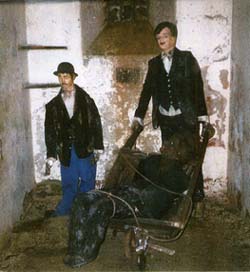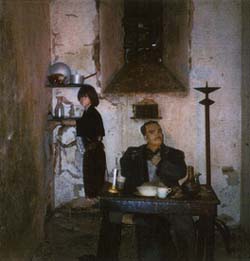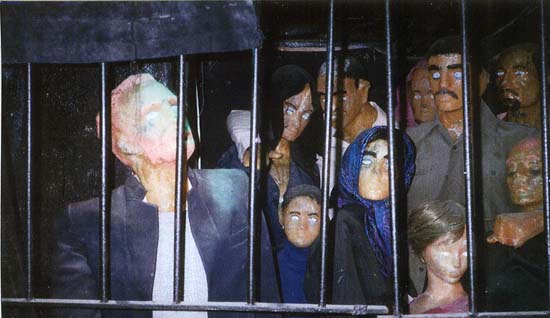Coffee, Tee or Pillory? An Afternoon at Bodmin Jail
by Jean E. Bellamy
A visit to the former Cornwall County prison can be a scary
experience for those of a fearful disposition. The grim building
dates back to 1776 and the exhibition within its austere walls
has doubled in size since it first opened. Nothing daunted,
however, we bought our tickets and having been pointed in the
right direction, set off below stairs to the dungeons, the
comforting words, "See you in the morning!" ringing in
our ears.
 Former inmates, depicted in tableaux in their squalid
surroundings, present a vivid picture of the way in which crime
was dealt with in the times of our forbears. Some folk may find
the lifelike dummies occupying the gruesome cells a little too
realistic, and as for those sinister figures lurking unexpectedly
around dark corners, they are calculated to frighten the
nervously disposed out of their wits. Former inmates, depicted in tableaux in their squalid
surroundings, present a vivid picture of the way in which crime
was dealt with in the times of our forbears. Some folk may find
the lifelike dummies occupying the gruesome cells a little too
realistic, and as for those sinister figures lurking unexpectedly
around dark corners, they are calculated to frighten the
nervously disposed out of their wits.
Every variety of crime is portrayed. Take, for instance, the case
of William Harding, a boy of 15, charged with stealing a basket,
the property of one, William Matta. Having been once before
convicted of larceny, the unfortunate youth was sentenced to
transportation for life. It was not so much the value of the
stolen property that had been taken into consideration, the
learned judge observed, as the fact that -- though young -- the
boy was a confirmed thief. It was therefore his duty to the
community to ensure that such persons should be sent out of the
country.
At the same Assizes, Joseph Perryman was indicted for stealing a
black hen and was sentenced to seven year' transportation. The
judge said that, in order to prevent persons prowling about for
plunder at the still and dead of night when property was
unprotected, the strong arm of the law must be administered.
Ann Holman got off more lightly. She was found guilty at the
Cornwall Quarter Sessions of 16th May 1813, of stealing milk from
a cow belonging to James Grey and was sentenced to just two
months' imprisonment. It was stated that the ease with which this
type of felony could be committed had induced the Bench to
inflict a punishment that might otherwise have been considered as
rather severe.
 A very much
harsher punishment was meted out to Elizabeth Osborne, committed
at Cornwall Assizes for setting fire to a mow of corn belonging
to Mr. John Lobb. She was sentenced to be hanged, the report of
the event appearing in the West Britain newspaper of 20th August
1813. Also reported at this time was the case of William Wallis,
found guilty of stealing and killing a sheep belonging to Mr.
Thomas Pethick. He too received sentence of death, as did James
Northey, convicted of housebreaking and robbing in the dwelling
of Mr. John Woodcock. On 12th August 1820, Sarah Polgreen was
hanged at the age of 37, having been found guilty of the charge
of murdering her husband by arsenic poisoning. A very much
harsher punishment was meted out to Elizabeth Osborne, committed
at Cornwall Assizes for setting fire to a mow of corn belonging
to Mr. John Lobb. She was sentenced to be hanged, the report of
the event appearing in the West Britain newspaper of 20th August
1813. Also reported at this time was the case of William Wallis,
found guilty of stealing and killing a sheep belonging to Mr.
Thomas Pethick. He too received sentence of death, as did James
Northey, convicted of housebreaking and robbing in the dwelling
of Mr. John Woodcock. On 12th August 1820, Sarah Polgreen was
hanged at the age of 37, having been found guilty of the charge
of murdering her husband by arsenic poisoning.
The last hanging in Bodmin Jail took place in 1909 and one can
see the exact spot where it occurred. Public hangings were
intended as deterrents but came to be regarded as popular
entertainments -- by those of a ghoulish turn of mind,
presumably! One public hanging went badly wrong. Wyatt, convicted
of the murder of Valentine, a Jew, at Fowey, fell off sideways
after the clergyman had left him, and it was twenty minutes
before an end was put to the unfortunate man's existence.
On a lighter note, 31 Christmases spent in prison was the record
of Samuel Glasson, blacksmith of Truro, charged on 19th June 1863
with being drunk and disorderly in the streets. On the previous
night he had been fined ten shillings and costs, but being in
default, he was committed to seven days' hard labour in the House
of Correction.
The previous prison life of this man disclosed some rather
startling facts. He had, it was believed, been committed to gaol
a greater number of times than any other man in Cornwall, having
eaten no less than thirty-one Christmas dinners there, and had
served in gaol upwards of 11 years. Said to render the case even
more singular was the fact that he had never once been charged
with felony, his committals to prison having always been for want
of sureties to keep the peace, and for assaults on the
police.

An unusual case was that of the tramp roped to a wheelbarrow.
He arrived at the Union House one evening and was given a night's
lodging. The following morning he refused to work, saying he
would leave the house unless he was given a new pair of boots. A
policeman was sent for, but the man would not walk to the lock-up
though he submitted to being roped to the wheelbarrow. So in this
rather bizarre fashion he was taken through the streets in the
custody of the policeman. The next day he had to be carried up
the town hall steps and would not stand before the magistrate but
lay on the floor during his examination. For which insolent
conduct it was reported in the West Briton Newspaper that Mr.
Coode "very properly gave him the heaviest punishment in his
power and committed him for twenty-one days at Bodmin Gaol."
The trouble did not end there, however, for in the court the man
was obliged to be roped down in the cart like a pig to be removed
to gaol.
Before leaving the prison, visitors can -- if they have the
inclination -- sit in the stocks or stand in the pillory for a
photograph with which to entertain friends back home. They can
also -- if they have the stomach for it after touring the
exhibition -- enjoy morning coffee, lunch or a cream tea in the
tea room of the licensed bar. There is also a souvenir shop and a
playroom with table tennis. The exhibition may be seen
from 10am (Saturday 11am) to 6pm all week all the year round and
there is free parking. It is interesting to note that the Crown
Jewels and Domesday Book were stored in the prison during the
Great War.
More Information:
We regret that we no longer have the resources to maintain up-to-date links and/or hours and pricing details for the various sites and attractions listed on this website. For more information about the location(s) listed above, please use your favorite search engine or visit Wikipedia.
Jean Bellamy has been writing since 1970, and is the author of over 300 published articles and short stories. She has written three children's novels (all with a "West Country flavour"). A resident of Dorset, she is the author of several local history books, including Treasures of Dorset, A Dorset Quiz Book, Second Dorset Quiz Book, Dorset Tea Trail, Dorset as she was spoke, Little Book of Dorset, 101 Churches in Dorset, and Cornwall: A Look Back. Jean loves to explore and write on all things British.
Article © 2006 Jean Bellamy
Photos courtesy of Bodmin Jail
|
